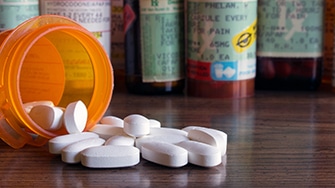What is the Definition of “Opioid”?
The definition of opioid is as follows: Opioids are a class of drugs that include the illegal drug heroin, synthetic opioids such as fentanyl, and pain relievers available legally by prescription, such as oxycodone, hydrocodone, codeine, morphine, and many others.
Opioids work by interacting with the opioid receptors on nerve cells in the body and brain. By interacting with these receptors, opioids medications are able to cut off communication between the pain point on the body to the brain. This chemical interaction gives it’s users pain relief that is too great for over-the-counter medications to soothe. Opioids are especially helpful when someone has experienced a painful injury, surgery, or another type of chronic pain.
A side effect of opioid medications is that they produce a euphoric feeling. This euphoria is what many individuals become addicted to because it triggers the reward system in the brain. When this system becomes triggered, the brain is essentially tricked into thinking that opioids are good for the body and essential, which keeps people addicted and coming back for more.
What are Examples of an Opioid?
There are a few different forms of opioids, including natural and man-made (or synthetic). These two types are further broken down into prescription opioids used for pain management or non-prescribed illegal street drug opioids.
Examples of opioids include:
- Vicodin
- OxyContin
- Percocet
- Opana
- Kadian
- Avinza
- Codeine
- Fentanyl
- Heroin
How Opioid Addiction Occurs
According to Truth Initiative, opioid dependence can happen after just 5 days. When someone begins using opioids – even if it is prescribed for pain management – and the reward system is triggered, the euphoric feeling opioids produce becomes irresistible. This will cause repeated use which builds a tolerance. Building tolerance happens when the individual requires more opioids in order to feel the euphoria, and this eventually leads to dependency and addiction.
The euphoric high that sets off the reward system in the brain is a the result of a dopamine rush which makes the body feel good. But, this feeling doesn’t last long and it leaves the brain wanting more and more. Eventually, the brain begins to adapt to the presence of opioids and stops producing its own, which can cause unpleasant withdrawal side effects when an individual hasn’t provided the body and brain with opioids in a period of time.
Opioid Addiction Statistics
- Nearly 80 percent of heroin users started with prescription opioids
More than 115 people died of opioid overdoses every day in America in 2016 - Opioid-related deaths accounted for nearly two-thirds of the approximately 63,632 Americans who died of a drug overdose that year
- In 2018, it is estimated that more than 2 million Americans will suffer from addiction to prescription or illicit opioids
- Roughly 21 to 29 percent of patients prescribed opioids for chronic pain misuse them
- An estimated 4 to 6 percent who misuse prescription opioids transition to heroin
- The Midwestern region saw opioid overdoses increase 70 percent from July 2016 through September 2017
When to Get Help
When an individual has been prescribed opioid medication for pain relief, it is important to know the signs and symptoms of addiction. Even under medical supervision, addiction can occur from the medication being over-prescribed or the body responding differently than others.
- Taking higher doses than prescribed. This is usually the first sign of addiction with individuals who become addicted to a prescription. If you find yourself or a loved one taking more than prescribed, it is time to speak to your doctor.
- Drug-seeking behavior. This can include having multiple pharmacies in order to fill multiple prescriptions from multiple doctors. It can also include purchasing opioids from the street illegally.
- Unable to stop or slow use due to intense cravings. This is a hallmark sign of addiction and should be taken very seriously.
- Physical and behavioral changes. Signs to look out for include marked weight gain or loss, increased mood swings, a generally unkempt appearance, and isolation from family or loved ones.
- Negative consequences due to opioid use. These can include legal issues, financial problems, work or school performance declining, or fractured family relationships such as divorce.
- Inappropriate use. Using opioids at inappropriate times can include before or during work hours, becoming high first thing in the morning, or situations that could be hazardous such as while driving.
About Cliffside Malibu
Opioids can be a very helpful medical intervention for people who are experiencing intense, chronic pain. However, they are dangerous drugs that can cause life-threatening side-effects. Overdosing from opioids due to addiction can be fatal, so it is very important to get help right away if you or a loved one is experiencing any of the signs of addiction.
Since no two addictions are the same, Cliffside Malibu offers an individualized treatment plan for each and every client. We are committed to providing the best care possible through a continuum of care including medically supervised detox, residential treatment, day treatment, and outpatient services. Our program includes not only evidence-based behavioral therapy but family therapy and holistic therapy, as well. Whether an individual is suffering from substance abuse and/or alcohol addiction, our programs are designed and structured to be a supportive environment in order to maintain sobriety.
In addition to world-class treatment, Cliffside Malibu offers luxury accommodations, a serene environment, five-star dining, and plentiful amenities. We understand that addiction treatment is a rigorous process. Therefore, we provide for your comfort and relaxation at every turn, allowing you to rejuvenate, to meet the demands of treatment with your greatest energy and attention.
For more information on Cliffside Malibu, visit cliffsidemalibu.com
